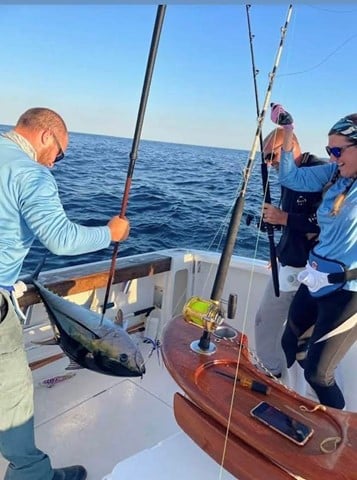Hey there! So, winter is here and it’s time to get your tackle ready for offshore fishing. Here are a few off season prep tips:
1. Offshore Lure Maintenance and Sharpening:
Ensuring sharpness of your lures is of utmost importance. Once your lures have been assessed for damage, proceed with sharpening them using appropriate tools and techniques. It is advisable to utilize a fine grit sharpening stone or a specialized lure sharpener to achieve the desired sharpness. Firmly hold the lure and gently glide the sharpening tool along its edges, ensuring an even and consistent sharpening.
During this process, it is crucial to maintain a steady hand and exercise caution to prevent any accidental injuries. Furthermore, it is essential to pay close attention to the angles at which the lure’s edges are being sharpened, as this can significantly impact its effectiveness in attracting fish. It is recommended to store the sharpened lures in a suitable container or tackle box, ensuring they are protected from potential damage or corrosion.
2. Line Crimping
Is essential in order to prevent any potential breakages while engaging in the exhilarating pursuit of reeling in substantial catches. First gather the necessary tools and materials. These typically include a high-quality crimping tool, suitable crimp sleeves, and the fishing line itself.
The next step involves selecting an appropriate crimp sleeve that corresponds to the diameter of the fishing line being utilized. It is crucial to match the size of the crimp sleeve to the line, as an ill-fitting sleeve may result in weakened connections and potential line failure. With the correct crimp sleeve in hand, the fishing line should be threaded through the sleeve, ensuring that a sufficient length of line extends beyond the sleeve for optimal crimping. It is essential to maintain a steady and firm grip on the line during this procedure.
Once the line is securely threaded through the crimp sleeve, the crimping tool should be carefully positioned over the sleeve. Make sure to apply steady and even pressure when crimping, ensuring that the sleeve is compressed uniformly and tightly around the fishing line.
After the crimping process is completed, it is advisable to inspect the crimped connection thoroughly. Any signs of irregularities, such as loose or misshapen crimps, should be fixed immediately. It is important to prioritize the integrity of the crimped connection, as any weaknesses or imperfections may lead to potential line failures and the loss of prized catches.
3. Offshore Reel Maintenance.
This is an essential task that should be carried out regularly to ensure the optimal performance and longevity of your fishing equipment. Start by rinsing the reel with fresh water to remove any loose debris. Use a soft brush or toothbrush to gently scrub away any stubborn dirt or grime. Pay close attention to the reel’s various components, such as the spool, handle, and drag system, ensuring that they are thoroughly cleaned.
After cleaning, it is important to lubricate your offshore reel to maintain its smooth operation. Apply a small amount of reel oil or grease to the moving parts, such as the gears and bearings. This will help reduce friction and prevent premature wear and tear. Be cautious not to over-lubricate, as excess oil or grease can attract dirt and impede the reel’s performance.
It is advisable to store your offshore reel properly when not in use. Avoid exposing it to extreme temperatures, direct sunlight, or moisture, as these can cause corrosion and deterioration. Consider investing in a reel cover or case to provide additional protection during storage or transportation.
4. Offshore Rod Maintenance.
Before storing your fishing rods for the winter, it is essential to thoroughly clean it to remove any salt, dirt, or debris that may have accumulated. Start by rinsing the rod with fresh water, paying close attention to the reel seat, guides, and handle. Use a mild soap or detergent to gently scrub away any stubborn stains or residue. Once cleaned, dry the rod completely using a soft cloth, ensuring that no moisture remains. This step is crucial to prevent corrosion and damage caused by the harsh winter conditions.
Next, the roller guides. These components play a vital role in ensuring smooth line movement and reducing friction during fishing. To maintain their functionality, it is recommended to inspect each roller guide for any signs of wear or damage. If you notice any cracks, chips, or loose parts, it is advisable to replace them before storing the rod for the winter. Additionally, lubricating the roller guides with a high-quality reel oil or grease will help prevent rust and ensure smooth operation when you resume fishing in the spring.
5. Educate Yourself.
Join fishing forums and communities: Engage with experienced offshore anglers by joining online fishing forums and communities. Participate in discussions, ask questions, and seek advice from seasoned professionals. This platform can provide valuable insights and practical tips.
Attend seminars and workshops: Look for local fishing seminars and workshops organized by fishing clubs or professionals. These events often feature expert speakers who share their knowledge and experiences. Take notes, ask questions, and network with fellow enthusiasts to expand your understanding of offshore fishing.
Watch instructional videos: Online platforms such as YouTube offer a plethora of instructional videos on various fishing techniques. Watch videos specifically related to offshore fishing, paying attention to details such as bait selection, rigging, casting, and reeling. Take notes and practice the demonstrated techniques.
Practice knot tying and rigging: Offshore fishing often requires specific knots and rigging techniques. Dedicate time to practice tying knots such as the Palomar knot, uni knot, improved clinch knot, loop knot, etc. Experiment with different rigs, such as Carolina rigs or dropper loop rigs, to become proficient in setting up your tackle.
Stay updated with technology: Offshore fishing is constantly evolving with advancements in technology. Stay informed about the latest fishing gear, electronics, and navigation systems. Research and understand how these tools can enhance your fishing experience and improve your chances of a successful catch.
Reflect and evaluate: Continuously evaluate your progress and reflect on your experiences. Identify areas where you need improvement and set goals for the upcoming fishing season. Keep a fishing journal to record your observations, techniques, and lessons learned.
Let’s get our tackle ready and make the most out of this winter fishing season!

